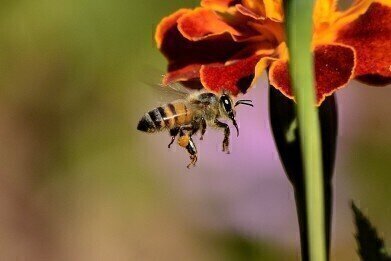News & Views
How Do Bees Find Flowers? It's Electric!
Jul 13 2016
For the most part, bees tend to buzz around minding their own (honey) business. However lately, the fuzzy flying insects have found themselves in the spotlight as environmentalists voice loud concerns over global bee decline.
And thanks to scientists like Gregory Sutton of the University of Bristol, we’re continually making new discoveries that help to combat colony collapse. He always knew that there was an intrinsic relationship between flowers and bees, but couldn’t pinpoint exactly what it was that attracted the insects in the first place. And more importantly, how they could distinguish between different species.
It’s all about the fuzz
While most people would cite colour or smell as possible factors, Sutton asserts that the monogamous relationship is in fact, electric! In a study published in the Proceedings of the National Academy of Sciences, Sutton explains that the fuzz covering the bodies of bees is about more than just aesthetics. Using their tiny hair follicles, bees are able to sense the natural electric fields of flowers, and hone in on their favourite plants. This essentially allows them to choose what species they want to pollinate.
"The bumblebees can feel that hair bend and use that feeling to tell the difference between flowers," says Sutton.
Electroreception on dry land
While the concept of electroreception isn’t new, its unique to see it at work in a land organism. Sharks, eels and platypuses are all equipped with the ability, yet the presence of water is a keynote factor. That said, the British bees studied by Sutton and his team are able to detect the minute electric charge fluctuations emitted by flowers, despite the fact that there’s no water to carry the vibrations.
"So, we looked at the big fuzzy hairs on the bumblebees: They're so fuzzy!" Sutton exclaimed in an interview with Christian Science Monitor.
An insect wide phenomenon?
Sutton and the team confirmed this theory by using an ultra-sensitive laser beam to detect tiny motions in the hairs. An electrode was used to record activity in nerve cells, with results showing that the fuzzy strands warped in response to electric fields. This stimulus then sends signals to the nervous system, which allows the bees to sense the presence of electric fields, and respond accordingly.
"I'm very excited by this because these little mechanically sensitive hairs are common all over the insect world," says Sutton. "I think this might be something we see in more insects than just bumblebees."
They may be small, yet bees play a crucial role in global ecosystems. ‘Continuous Focus on Sample Management. Improving Productivity via LIMS’ spotlights the role of the Food and Environment Research Agency, and its efforts to develop a sustainable food chain, promote a healthy natural environment and protect the global community from deliberate chemical, biological, radiological and nuclear (CBRN) or major accidental Hazardous Material (HazMat) incidents.
Digital Edition
Lab Asia 31.2 April 2024
April 2024
In This Edition Chromatography Articles - Approaches to troubleshooting an SPE method for the analysis of oligonucleotides (pt i) - High-precision liquid flow processes demand full fluidic c...
View all digital editions
Events
Apr 25 2024 Istanbul, Turkey
Apr 28 2024 Montreal, Quebec, Canada
May 05 2024 Seville, Spain
InformEx Zone at CPhl North America
May 07 2024 Pennsylvania, PA, USA
May 14 2024 Oklahoma City, OK, USA


















